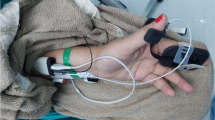Abstract
General anesthesia and central neuraxial blockades in patients with severe Duchenne muscular dystrophy are associated with high risks of complications, including rhabdomyolysis, malignant hyperthermia, hemodynamic instability, and postoperative mechanical ventilation. Here, we describe peripheral nerve blocks as a safe approach to anesthesia in a patient with severe Duchenne muscular dystrophy who was scheduled to undergo surgery. A 22-year-old male patient was scheduled to undergo reduction and internal fixation of a left distal femur fracture. He had been diagnosed with Duchenne muscular dystrophy at 5 years of age, and had no locomotive capability except for that of the finger flexors and toe extensors. He had developed symptoms associated with dyspnea 5 years before and required intermittent ventilation. We blocked the femoral nerve, lateral femoral cutaneous nerve, and parasacral plexus under ultrasound on the left leg. The patient underwent a successful operation using peripheral nerve blocks with no complications. In conclusion general anesthesia and central neuraxial blockades in patients with severe Duchenne muscular dystrophy are unsafe approaches to anesthesia because of hemodynamic instability and respiratory depression. Peripheral nerve blocks are the best way to reduce the risks of critical complications, and are a safe and feasible approach to anesthesia in patients with severe Duchenne muscular dystrophy.


Similar content being viewed by others
References
Biggar WD, Klamut HJ, Demacio PC, Stevens DJ, Ray PN. Duchenne muscular dystrophy: current knowledge, treatment, and future prospects. Clin Orthop Relat Res. 2002;401:88–106.
Gurnaney H, Brown A, Litman RS. Malignant hyperthermia and muscular dystrophies. Anesth Analg. 2009;109:1043–8.
Hayes J, Veyckemans F, Bissonnette B. Duchenne muscular dystrophy: an old anesthesia problem revisited. Paediatr Anaesth. 2008;18:100–6.
Goresky GV, Cox RG. Inhalation anesthetics and Duchenne’s muscular dystrophy. Can J Anaesth. 1999;46:525–8.
Wick S, Muenster T, Schmidt J, Forst J, Schmitt HJ. Onset and duration of rocuronium-induced neuromuscular blockade in patients with Duchenne muscular dystrophy. Anesthesiology. 2005;102:915–9.
Yemen TA, McClain C. Muscular dystrophy, anesthesia and the safety of inhalational agents revisited; again. Paediatr Anaesth. 2006;16:105–8.
Muenster T, Schmidt J, Wick S, Forst J, Schmitt HJ. Rocuronium 0.3 mg kg−1 (ED95) induces a normal peak effect but an altered time course of neuromuscular block in patients with Duchenne’s muscular dystrophy. Paediatr Anaesth. 2006;16:840–5.
Almenrader N, Patel D. Spinal fusion surgery in children with non-idiopathic scoliosis: is there a need for routine postoperative ventilation? Br J Anaesth. 2006;97:851–7.
Smith CL, Bush GH. Anaesthesia and progressive muscular dystrophy. Br J Anaesth. 1985;57:1113–8.
Braun DL. Spinal, epidural, and caudal anesthesia. In: Miller RD, editor. Miller’s Anesthesia. 7th ed. Philadelphia: Churchill Livingstone; 2009. p. 1616–8.
Harper CM, Ambler G, Edge G. The prognostic value of pre-operative predicted forced vital capacity in corrective spinal surgery for Duchenne’s muscular dystrophy. Anaesthesia. 2004;59:1160–2.
Carpenter RL, Caplan RA, Brown DL, Stephenson C, Wu R. Incidence and risk factors for side effects of spinal anesthesia. Anesthesiology. 1992;76:906–16.
Moore DC, Bridenbaugh LD. Spinal (subarachnoid) block. A review of 11,574 cases. JAMA. 1966;195:907–12.
de Visme V, Picart F, Le Jouan R, Legrand A, Savry C, Morin V. Combined lumbar and sacral plexus block compared with plain bupivacaine spinal anesthesia for hip fractures in the elderly. Reg Anesth Pain Med. 2000;25:158–62.
Parkinson SK, Mueller JB, Little WL, Bailey SL. Extent of blockade with various approaches to the lumbar plexus. Anesth Analg. 1989;68:243–8.
Author information
Authors and Affiliations
Corresponding author
Ethics declarations
Conflict of interest
None of the authors had conflicts of interest in relation to this study or received funding by the manufacturer.
About this article
Cite this article
Bang, S.U., Kim, Y.S., Kwon, W.J. et al. Peripheral nerve blocks as the sole anesthetic technique in a patient with severe Duchenne muscular dystrophy. J Anesth 30, 320–323 (2016). https://doi.org/10.1007/s00540-015-2127-4
Received:
Accepted:
Published:
Issue Date:
DOI: https://doi.org/10.1007/s00540-015-2127-4




